
Article by Whian Whian Landcare
In 2017-2018 Whian Whian Landcare embarked on an experimental project to improve the quality of water runoff from a local macadamia farm.
The project was seeded in a conversation between a Landcare coordinator, Hannah Rice-Hayes and local macadamia farmers Bruno Bertolo and Steve Genrich (from WW Landcare), about a consistently wet, hard to manage setaria patch in the middle of their orchard. Conventional logic is to drain agricultural areas for easier management, but Hannah suggested the opposite may be more beneficial.
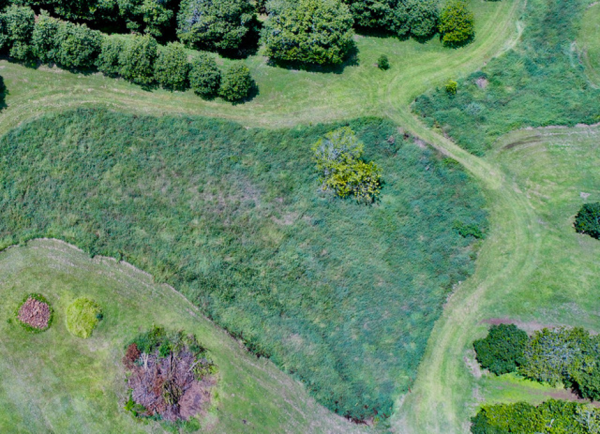 Picture of original site
Picture of original site
The idea took hold and a proposal for a constructed wetland was written into a Local Land Services Targeted Engagement Grant application by Emma Stone (From WW Landcare), to "Work on Water in Whian Whian". The proposal was to create a wetland like system to capture the silt and filter nitrates that traditionally run off orchard floors (a widespread issue in the industry), and thus improve the quality of water leaving the property. The wetland and its plantings could become habitat for insectivores such as beneficial insects, microbats and birds, which would assist in the farmer's aspiration towards integrated pest management in the orchard. The improved aesthetic values of a wetland were also keenly anticipated.
After being awarded the grant, a working group explored the actual design of the wetland system. None of us had expertise in constructed wetlands so we reached out into the network for advice. Many local people with expertise in soils, native plants, wetlands, earthworks, landscape design and natural wastewater treatment were called on to visit the site and offer their expertise, generously donating their time. Andrew Pawsey, a landscape architect convinced us to apply natural sequence farming ideas of a chains of ponds and leaky weirs to the design. Contours were mapped and a notional design was drawn up. Water on water was something Andrew was aiming for to take the power out of flows and filter sediment.
During construction, there was further collaboration as the creative energies of Bruno, Andrew and the earthmoving operator, Jeremy Stewart, freestyled a more meandering system of a chain of ponds. The site constraints and opportunities (ingress of water and heavy clays) also became a silent but irrepressible determinant of what was possible in a given amount of time. Variable levels and underwater shelves were created to provide suitable planting conditions for a range of plants. An existing mound with established vegetation was left to further provide a variety of levels in the landscape for different plants and microhabitats.
Deepwater (>2m) was incorporated to have clearwater from plants. This would allow for recreational swimming and an area where microbats could drink on the wing. The setting of weir heights was critical; low weirs with small falls were incorporated as well as overflow points with rocky protection for larger falls.

Above is a drone photo of the site immediately after earthworks.
The plants role in the system is to further slow the water down, feed and filter the nutrients out the water, as well as provide food and shelter for a range of insects, amphibians, aquatic life and birds.
Within six months the site was transformed into a young oasis. Native animals unseen before in that area had moved in. The first field day was organised, demonstrating the wetland to other macadamia growers. Soil loss and turbid nutrient laden runoff is a major issue that the macadamia industry has been attempting to address for years. The wetlands provided a nature based solution to help address this, as well as having many other farm and ecological benefits.
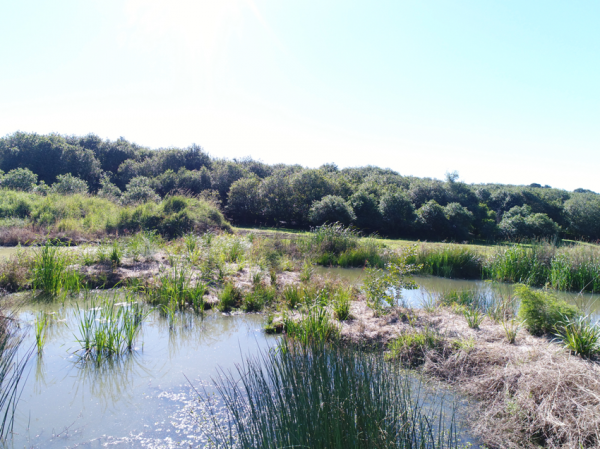
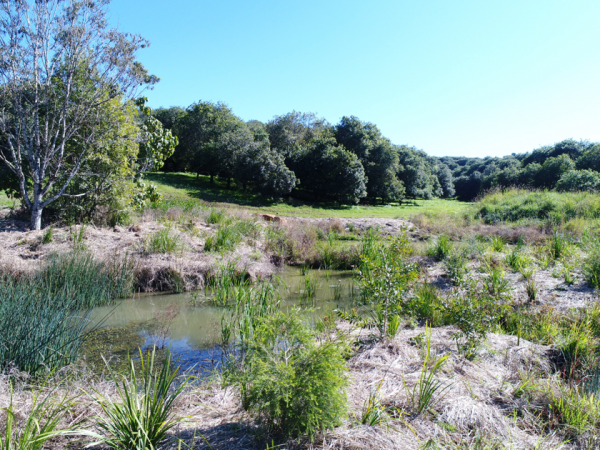
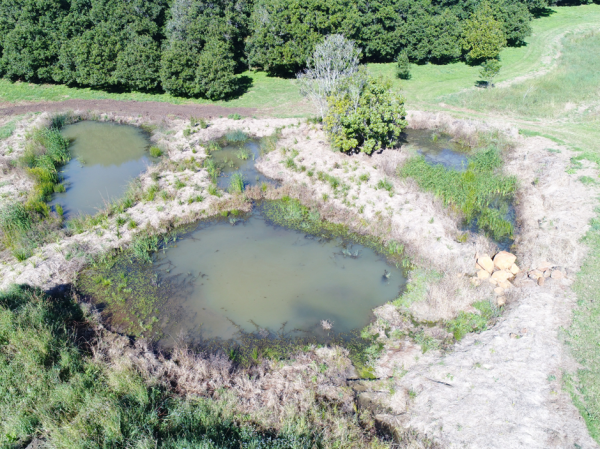 Above are drone photos of the site about 6 months on.
Above are drone photos of the site about 6 months on.
That was the extent of the grant undertaking and the group could have left it there. What was remarkable however it that it inspired a whole range of additional actions from the group which extended the project in diverse, unexpected and far reaching ways.
Arising from the field day the group was offered to contribute an article to the Australian Macadamia Society Magazine. This further evolved to one of WWLC's members being invited to speak at an Australian Macadamia Industry Conference and the National Landcare Conference. The Federal Shadow Minister for Agriculture Joel Fitzgibbon visited the site and Bruno had a radio interview broadcast on the ABC Country Hour.
The wetlands were viewed as a great focal point for environmental education. Emma Stone organised two primary school projects centered around the wetland. The first involved students from a couple of local schools weekly monitoring the sediment load in various points in the creek system and the comparison with rainfall. While the results were quite predictable it did provide a very visual display of sedimentation of our waterways and awaken they awareness. The kid's interest grew and members organised a tour of an environmental laboratory and science labs at the Southern Cross University.
The second project Emma coordinated a citizen science field day for students from a local primary school to investigate insects in different environments on the farm comparing the orchard to the bushland and the wetlands.. The project involved students from primary school collecting, counting, drawing and describing insects.
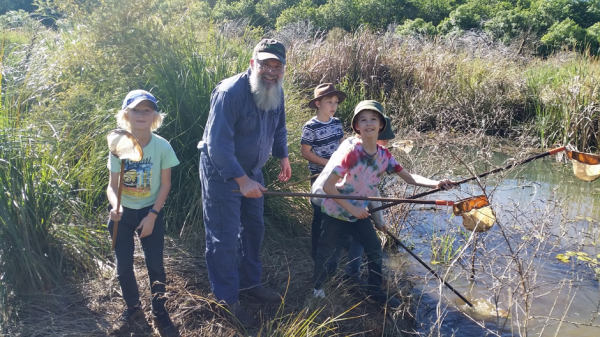 Photo of Bruno and some students bugging out at the wetland about 18 months on.
Photo of Bruno and some students bugging out at the wetland about 18 months on.
Dr John Grant (from WW Landcare and Southern Cross University - SCU) found opportunities for his students to extend research within their studies, and bring some serious science into evaluating the project.
In her final year of a Bachelor of environmental science, Ella Bickenstaff prepared a report encapsulating the expectations of parties, the planning and construction phases and undertook baseline assessments of biota and water quality. The report provided an extremely useful summary of the project for the participants as well as providing a blueprint for others to follow. It recorded preliminary evidence of species change indicating improvement of habitat.
Another SCU student, Gareth Jones, undertook a follow up survey of the wetland in 2019, recording a wide range of species that are using the wetland and detailing the impact of the wetlands on the down-stream water quality. Gareth found the wetland was effectively capturing sediment run off from the small sub catchment, significantly improving water quality. The study also showed that soil erosion as recorded by deposition within the ponds was low in relation to other horticultural crops in the area and particularly in relation to recorded levels of soil loss in macadamia orchards.
Dr Grant reflected that the opportunity for local university students to link into on ground works with Landcare, LLS, a landscape architect, farmers and contractors provided those students with a fantastic opportunity to finish their degrees on projects that gave them a springboard into new careers.

#WaterQuality#MacadamiaFarming#Wetlands#CoastWaterways#HabitatRestorationRevegetation#NSW#ThisWorksHere